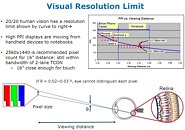Friday, April 13th 2012

Intel to Push for Higher Resolution PC Displays, Arrive in 2013
Come 2013, and PC consumers could finally break the shackles of regressive PC resolution "standards" such as 1366x768 and 1920x1080, if Intel has its way. At a presentation at IDF Beijing, Intel expressed its desire to see much higher resolution displays for all computing devices, not just PCs, which could in true terms be "retina-matched" display resolutions. At an optimal (comfortable) viewing distance, the resolution of a computing device's screen should match that of your eyes.
If Intel has its way, a 21" all-in-one desktop PC, and a 15" notebook PC screen will have a resolution of 3840x2160 pixels; a 13" Ultrabook PC could have a resolution of 2800x1800 pixels, a 11" Ultrabook and 10" tablet with 2560x1440, and 5" handheld/smartphone with 1280x800. Compare these to the $500+ 27" 1920x1080 monitors that are still sold in the market! A very bold proposal, but one only a company with the industry prominence of Intel can pull off.
Source:
Liliputing
If Intel has its way, a 21" all-in-one desktop PC, and a 15" notebook PC screen will have a resolution of 3840x2160 pixels; a 13" Ultrabook PC could have a resolution of 2800x1800 pixels, a 11" Ultrabook and 10" tablet with 2560x1440, and 5" handheld/smartphone with 1280x800. Compare these to the $500+ 27" 1920x1080 monitors that are still sold in the market! A very bold proposal, but one only a company with the industry prominence of Intel can pull off.



88 Comments on Intel to Push for Higher Resolution PC Displays, Arrive in 2013
I just hope they bring high res monitors with 16:10 since it's far superior to 16:9 imo.
but for professional/workstation & studio design & media editing, the IGP seems to be on track and higher res 'might' not be a problem..
Seriously, the only ones who would really care about high resolutions are gamers and professionals. Regular users don't know the difference between 720 and 1080 other than that one is a higher number than the other.
I don't mind an effort by the industry to boost resolutions, but coming from Intel it means nothing unless they can supply an IGP that can at least compete in the midrange segment.
I'm not trying to be an ass but I have my priorities. I'll just chalk this up to a loss for my concerns.
thank you intel :)
Also game developers and/or AMD/Nvidia could work out a feature similar to MLAA or FXAA where the input is 1080p and the output is 2160p, performing anti-aliasing a lot better than they do now while keeping all the details that are now lost with those algorithms. Or color/textures could be sampled at 2160p, while lighting/shaders are calculated at lower res (many game engines already do this anyway) or many other techniques that would allow for 2160p on current gen cards no problem.
I'm comfortable enjoying my dvd and bluray movie on both 720p and 1080p display.
Playing a dvd or 720p movie on 3k res=eye cancer.
but if this gigantic res could push the standard HD video to match the res,I'd be glad to jump ship.
This is good news. I'll stay on the bleeding edge of res if the monitors are affordable.